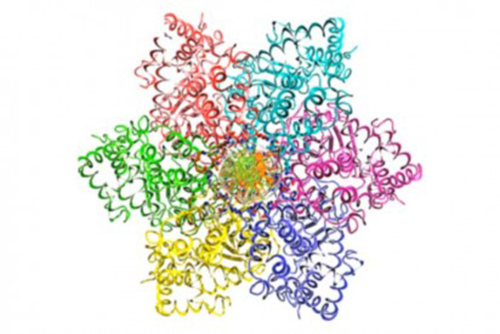
A ring of six proteins known as a helicase surrounds the DNA strands at a special location. Each of the six proteins is in distinct color, with origin DNA in the center. (Credit: Xiaojiang Chen)
After being perplexed for years, scientists may have finally been able to understand how the double-helix DNA replicates.
Researchers at USC have concluded that the double helix DNA is prompted to start replication by a ring of proteins that bond with the DNA at a special location known as “origin DNA.”
Xiaojiang Chen, Ph.D., a professor of biological sciences and chemistry at the USC Dornsife College of Letters, Arts and Sciences and director of the college’s Center of Excellence in NanoBiophysics and corresponding author of the study, explained how the discovery will be used in the future.
“Understanding the mechanisms of origin DNA opening or melting allows us to learn this fundamental process of genetic duplication,” he said in a statement. “The knowledge we have gained may be applicable for future intervention of this process to block the replication of viral pathogens and cancer cells.”
According to the scientists, the ring of proteins tightens around the two double-helix DNA strands and melts them to open up the DNA and initiate replication.
This occurs at a nano level, leaving it impossible to see at the naked eye, leaving scientists unsure on the actual process. A strand of DNA is only about one nanometer in size, significantly smaller in width of a human hair.
However, the researchers made their discovery after studying a cancerous virus—SV 40—after the virus linked to brain and bone cancers, mesothelioma and lymphoma, hijacked the DNA replication process with a ring of proteins called a helicase that mimicked the rings of proteins that prompt genetic replication in healthy cells.
The double helix divides into separate strands after the origin DNA melts, according to Chen. The strands then become the template for faithful duplication of other strands and as soon as replication is complete, one double helix DNA becomes two exact copies of the same double helix.
“DNA replication is critical for heredity and survival,” Chen said. “The origin DNA’s opening is an essential step for DNA replication in our cells and for some tumor viral pathogens to replicate and spread.”
The scientists used a helicase from a “Large Tumor Antigen,” which contains six proteins to form a helicase that mimics the structure of the healthy cells’ helicases to prompt replication.
The research team was able to obtain a 3D view of the atomic structure of the helicase using X-ray crystallography, a technique for examining nano-biomolecules and their structures at the atomic level that has been refined over centuries.
According to Chen, the images showed that the proteins surrounding the DNA had attached to it, then tightened like a vice until the bonds between the strands of the double helix broke or melted the origin DNA.
While regular DNA contains the A, T, G and C nucleotides—more or less in equal ratio—origin DNA sequences contain more A and T nucleotides than usual.
The breakthrough could lead to a better understanding of how organisms replicate and multiply for their survival.
Other co-authors of this study included Dahai Gai, also of USC Dornsife, Damian Wang of the Keck School of Medicine at USC and Shu-Xing Li of USC Dornsife’s Center for Excellence in NanoBiophysics.
The study was published on Dec. 6 in eLife.




